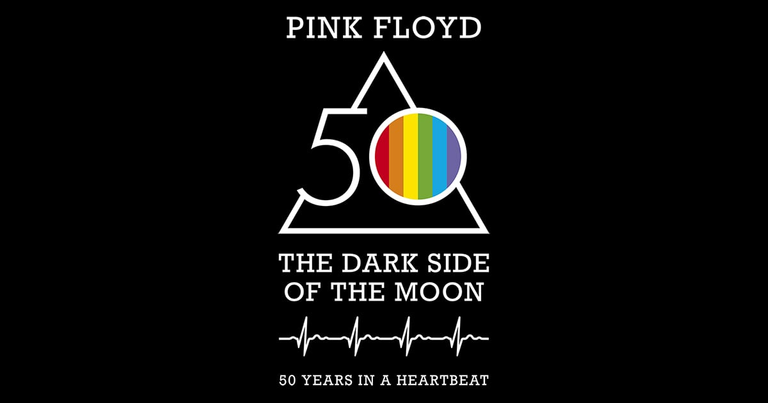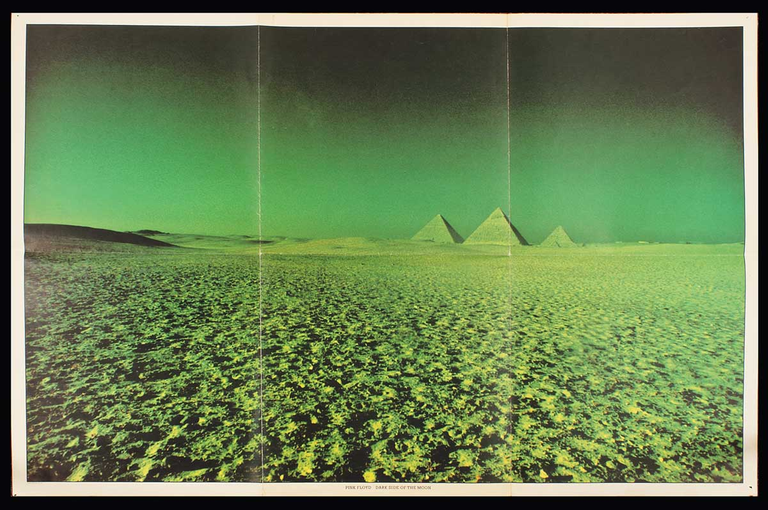
Pink Floyd 50 years of The Dark Side of the Moon - images may be subject to copyright
In 1973, going to a record store was quite an odyssey. It was about looking for the innovative, that sound that would suddenly change the way of listening and making music. Hi-fi sound equipment had just become popular and music lovers had begun to become demanding when it came to appreciating each piece of music and its production. In this context, standing out from the shelves or the windows of these spaces was important for the record to be sold, but it was also a privilege that few had.

Dark Side of the Moon - Pink Floyd
Albums released that same year included Red Rose Speedway and Band on the Run by Wings, Black Sabbath's Sabbath Bloody Sabbath, The Who's Quadrophenia, Selling England by the Pound by Genesis and David Bowie's Aladdin Sane. However, none of those works would attract as much attention as the vinyl of The Dark Side of the Moon by the British band Pink Floyd. That prism that refracts light against a dark background was hypnotic, it made the album something intriguing to discover.
The cover art was in charge of the english graphic designers, George Hardie, Storm Thorgerson and Aubrey Powell, the latter two members of the Hipgnosis designer collective. That group was famous for elaborate, photographic covers, but keyboardist Richard Wright asked them for a particularly elegant design. The members chose between seven sketches that were exhibited in a rehearsal room. They just walked in, looked at everything, said “That one!” and they went out. It is not a minor fact that one of the rejected designs had the Silver Surfer, a superhero from the Marvel comics, as its protagonist. For Aubrey, although they liked that image because it "had mystical and mythical properties", they would never have been able to get the permits. The edition also included a poster with images of the band live, another with a photograph of the pyramids of Giza taken with infrared film, and a sheet of stickers of them.

The iconic insert from The Dark Side of the Moon featuring the photo of the Pyramids of Giza taken by Aubrey Powell
The idea to make this record came up in late 1971 during a meeting at Nick Mason's house. An impending UK tour was putting pressure on the group as they did not have the time to produce quality material. Drugs, fear of death, the stress of flying, and money were taking a serious toll on bassist and singer-songwriter Roger Waters' mental health. The triangle symbolized ambition and madness, while the color spectrum alluded to the colorful lighting fixtures that had become characteristic of the band's shows. The beam continues on the back and is unlinked with heart rate towards the interior of the drop-down, thus linking the image with the content. To make it easier to arrange the record in record stores, Thorgerson proposed including another prism on the back cover.
A few weeks after the meeting, the first presentable version of the album was ready and was titled The Dark Side of the Moon: A Piece for Assorted Lunatics. While the band's previous records had been created with a piecemeal approach and had an air of desperation rather than inspiration, for this album the group discussed the goals and aspirations of the work and that helped stimulate their creativity. With lyrics written by Waters, the music was done in the studio during rehearsals and subsequently during recording sessions beginning in May 1972.
When Syd Barrett left the band in 1968 due to his drug addiction, Waters took responsibility for generating most of the lyrics. Despite the fact that the bassist and vocalist has once dismissed it as "teenage material", his words made the work the most open and specific to date with respect to content. For that very reason, it was the first time they saw fit to print them outright in the liner notes.

Pink Floyd with Syd Barrett during the sixties, before the singer left the band.
The live performance of the new record took place in mid-February 1972, almost a year before the record was due to be released, during a four-night series at London's Rainbow Theatre. In the book Inside Pink Floyd, drummer Nick Mason mentally walks through this dark auditorium with its torn decorations and comments that "it had a particular and vibrant atmosphere that took us back to our early days in the Roundhouse." For those concerts, the band had three truckloads of equipment: seven auditorium speakers and a 28-channel mixer with four quad outputs.
Although the live version of The Dark Side of the Moon was already well advanced, the constant interruptions meant that the recordings of the album stretched out throughout the year. The aforementioned tour of the United Kingdom, as well as those of the United States and Japan, had their share of stress. But the band also occupied their time with a few projects, like the soundtrack for the movie Obscured By Clouds, the premiere of the movie Live At Pompeii, and various concerts with Roland Pettit's Ballet de Marseille. Fortunately, the members of Pink Floyd did not feel oppressed by the amount of work, but it made them realize that they were professional musicians and very active. According to Nick, by the time of Atom Heart Mother they had been stuck, and all that work situation reinvigorated his sense of determination.
The sessions were held at EMI studios, later renamed Abbey Road. The atmosphere was a bit more youthful than on the band's previous visits, and this was because there was a new generation of engineers and tape operators who had grown up in the shadow of rock music and who understood the importance of having a good relationship with musicians. Thus, they were initially assigned Alan Parsons, who had previously been a tape operator at Atom Heart Mother, as in-house engineer.
In order to further intertwine the songs, Roger came up with the idea of recording some interviews with the venue's staff, both the roadies and anyone who worked there. The questions ranged from the banal, such as his favorite color and food, to the profound, his views on madness and death. Even Paul McCartney recorded some responses, but Waters felt they couldn't be used as the former Beatle was the only interviewee trying to be funny. In his book, Mason comments that both he and his partner were extremely cautious and reserved: "We had to have a very clear idea of what we wanted, otherwise it would have been unthinkable for us to turn down such famous voices."
When making the mixes, in February 1973, the group decided to bring in an external producer. For this work, Chris Thomas, who had worked as an engineer and was also part of the production company George Martin, was summoned. This inclusion was essential to be able to finish the album, since each musician had different preferences when choosing how a work was going to be heard and the elements that should stand out. For Waters and Mason, the work should be the result of experimenting with balance to enhance non-musical elements. Instead, Gilmour and Wright were looking for a musical approach. Also, David preferred a certain level of echo and Roger preferred a drier sound.
In his book, Mason asks himself why The Dark Side of the Moon was a bestseller and answers that for him there is not just one reason, but rather a series of reasons that coincided and multiplied its effect. It is that, for the artist, this was not only due to the musical quality of the members, but also because their songs have deep lyrics that are simple and clear so that everyone can understand them. There was something about the symbiosis of the musical talents of the four that worked very well.
Waters also recalls that when the recordings were finished he took a copy home and had his wife listen to it. The image of seeing her crying at the end made him think "this has struck a chord."
Finally, the album was released on March 1, 1973, and to this day it is one of Pink Floyd's most recognized. Its popularity was such that two weeks after its premiere it reached number 95 on the Billboard 200 list and did not fall from it until 1988. It is a deep and complex work, which at the same time manages to challenge those who listen to it and transmit that madness that is imposed metaphorically in the darkness of the moon.
HIVE 2023
